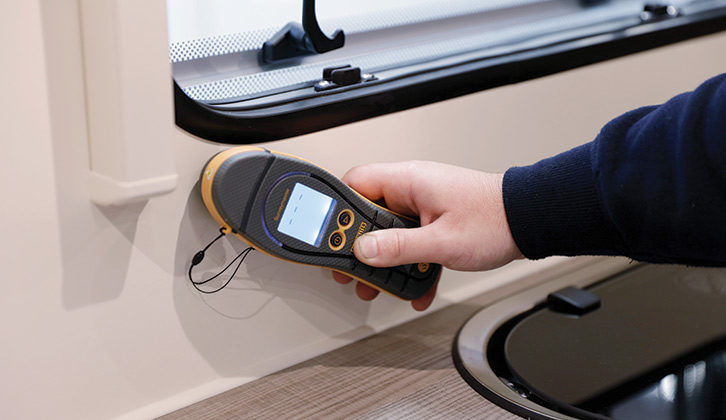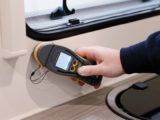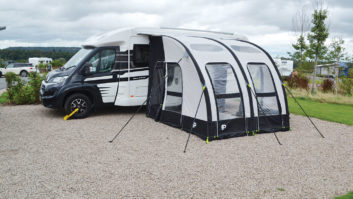A motorhome should be a place for making wonderful memories, but keeping your eyes peeled for signs of damp will be a key part of extending the longevity of your ‘van.
Moist air in a motorhome can be created by a number of factors, including condensation – caused by cooking and showering – and water ingress, where rain gets in through gaps. Knowing what to look out for will be important here, whether you’re checking your own ‘van or are looking to buy a pre-owned one – and if you’re on the hunt for one, our guide to the best used motorhomes is worth a look.
Shane Malpass of We Buy Any Motorcaravan explains: “Dampness is what happens when moist air gets trapped in a small or confined space. As motorhomes and caravans are confined living spaces by nature, they are the perfect trap for moist air. As the UK and Ireland are rainy countries with wet climates, there is always plenty of moist air that can easily get trapped inside.”
“Older motorhomes and caravans are more likely to suffer from severe damp, especially models that have wooden frames. While many of the newer models have designs intended to prevent water ingress, they are not immune and water may still get inside.”
To help you protect your ‘van, We Buy Any Motorcaravan are offering some suggested habits to get into when you’re cleaning your motorhome to help you check for signs of damp…
- Look around the seals and sealant found by the windows, seals and doors, along with anywhere you have drilled in any equipment (for example, aerial points or bike racks) and accessories into the main body.
- Examine the sealant for any signs of damage – this includes looking for cracks, peeling and knocks. If there’s been a recent heavy downpour, it could make it simpler to spot any water entry points.
- Internally, see if any of the cushions, curtains or similar have a musty smell.
- Make sure the wallboards are showing no signs of pimpling by running your hands over them; you’re checking for anywhere that feels wet or has a spongy texture.
- Check the walls for any discolouration – this can include black spots or marks. They could also go a blue or pinkish colour, which will typically occur near windows and lockers.
- Do the floors feel spongy or creak? This could be a sign of water ingress or damp.
- When water’s entering your vehicle, it can sometimes hitchhike on channels and pipes. This means it ‘dumps’ water in random parts of your ‘van, subsequently making it harder to identify where the entry point was – this is something to bear in mind when you’re checking for ingress.
- Check the internal screws for rust.
- If you’re looking at a pre-owned motorhome, be sure to keep an eye out for any signs of issues with damp; for instance, if some of the internal panels have been changed, it could be an indicator. Our guide to the interiors checks to carry out when looking at a used motorhome will help you identify other parts to look out for.
When you’re looking for signs of damp in your motorhome, a damp tester (a moisture meter) is a very useful tool that can be used wherever you think damp may be. However, if you’re doing more of a routine search, take a look at the following areas:
- Peel up and test behind the rubber on the windows
- The seats and inside any bed lockers
- Inside the cupboards
- The windows, doors and anywhere the seams run, including where the roof meets the ceiling – the standard ingress points
- Anywhere you’ve fitted your own accessories, such as cycle racks, awnings and similar.
If you liked this, why not read these:
- Looking to get your ‘van back to its sparkling best? Our guide to the best motorhome cleaners will be the place to go, as we run through the standout products on the market
- We talk you through the motorhome servicing DIY tasks you can carry out to keep your ”van in tip-top condition
Future Publishing Limited, the publisher of practicalmotorhome.com, provides the information in this article in good faith and makes no representation as to its completeness or accuracy. Individuals carrying out the instructions do so at their own risk and must exercise their independent judgement in determining the appropriateness of the advice to their circumstances. Individuals should take appropriate safety precautions and be aware of the risk of electrocution when dealing with electrical products. To the fullest extent permitted by law, neither Future nor its employees or agents shall have any liability in connection with the use of this information. You should check that any van warranty will not be affected before proceeding with DIY projects.
If you’ve enjoyed reading this review, why not get the latest news, reviews and features delivered direct to your door or inbox every month. Take advantage of our brilliant Practical Motorhome magazine SUBSCRIBERS’ OFFER and SIGN UP TO OUR NEWSLETTER for regular weekly updates on all things motorhome related.









